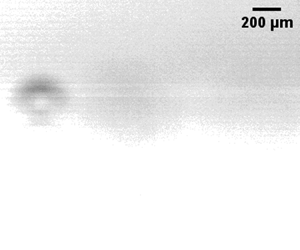Article contents
Oblique impact of microspheres on the surface of quiescent liquid
Published online by Cambridge University Press: 06 August 2020
Abstract

Impact of microspheres on liquid surfaces is a universal phenomenon in nature and in industrial processes. However, most relevant studies have mainly focused on the sphere's vertical impact. Herein, we present the first observation on the oblique impact of microspheres on the surface of quiescent liquid using high-speed microphotography. The sphere motion and liquid surface distortion after the oblique impact are basically different from those after a vertical impact. The sphere rotates and its trajectory deviates from the impact direction during the oblique impact process, while the non-axisymmetric liquid surface distortion experiences an evolution from half-cavity to full-cavity patterns. The dependence of motions of the sphere and the three-phase contact line on the impact angle  $\alpha$ and Weber number are investigated, and the scaling laws for the sphere's penetration time and penetration depth are given. We provide a phase diagram with respect to the Weber number and impact angle that describes the observed impact modes of submergence and oscillation, which shows that the critical Weber number between two impact modes increases when the impact angle decreases. Additionally, a scaling model is established based on energy balance to distinguish different impact modes. The model indicates that the critical Weber number for the microsphere's oblique impact is equal to
$\alpha$ and Weber number are investigated, and the scaling laws for the sphere's penetration time and penetration depth are given. We provide a phase diagram with respect to the Weber number and impact angle that describes the observed impact modes of submergence and oscillation, which shows that the critical Weber number between two impact modes increases when the impact angle decreases. Additionally, a scaling model is established based on energy balance to distinguish different impact modes. The model indicates that the critical Weber number for the microsphere's oblique impact is equal to  $1/{\rm sin}\,\alpha$ times that for vertical impact, agreeing well with the experimental results.
$1/{\rm sin}\,\alpha$ times that for vertical impact, agreeing well with the experimental results.
- Type
- JFM Papers
- Information
- Copyright
- © The Author(s), 2020. Published by Cambridge University Press
References
REFERENCES
Ji et al. supplementary movie 1
A 249 μm diameter PMMA sphere impacts a quiescent water surface with velocity u0 = 2.74 m/s (We = 34, Re = 894) and impact angle of 13.3°exhibiting an oscillation mode. The movie is played back at 1/2800 of real speed.
Ji et al. supplementary movie 2
A 240 μm diameter PMMA sphere impacts a quiescent water surface with velocity u0 = 2.89 m/s (We = 16, Re = 529) and impact angle of 29.5°exhibiting an oscillation mode. The movie is played back at 1/2800 of real speed.
Ji et al. supplementary movie 3
A 220.7 μm diameter PMMA sphere impacts a quiescent water surface with velocity u0 = 3.36 m/s (We = 34, Re = 740) and impact angle of 29.5°exhibiting an oscillation mode. The movie is played back at 1/2800 of real speed.
Ji et al. supplementary movie 4
A 284.9 μm diameter PMMA sphere impacts a quiescent water surface with velocity u0 = 3.59 m/s (We = 50, Re = 1021) and impact angle of 29.5°exhibiting an oscillation mode. The movie is played back at 1/2800 of real speed.
Ji et al. supplementary movie 5
A 306 μm diameter PMMA sphere impacts a quiescent water surface with velocity u0 = 2.84 m/s (We = 34, Re = 867) and impact angle of 43.8°exhibiting an oscillation mode. The movie is played back at 1/2800 of real speed.
Ji et al. supplementary movie 6
A 246.3 μm diameter PMMA sphere impacts a quiescent water surface with velocity u0 = 3.15 m/s (We = 34, Re = 774) and impact angle of 56°exhibiting an oscillation mode. The movie is played back at 1/2800 of real speed.
- 7
- Cited by




